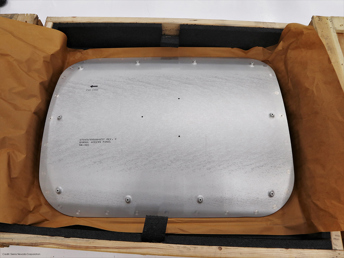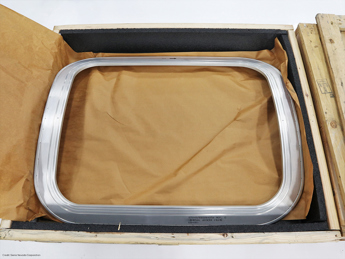Getting into Dream Chaser: Understanding the Dorsal Panel
May 21, 2020
The dorsal panel for Sierra Nevada Corporation’s Dream Chaser® spaceplane has arrived at our Louisville, Colorado production facility! It’s one of the larger installations that will be on the spacecraft. We caught up with the design lead, Seth, to explain why the dorsal panel is so crucial to the launch of Dream Chaser.
Why is the dorsal panel such a critical piece of Dream Chaser?
There are only two points of entry to get inside Dream Chaser – through our Shooting Star cargo module and the dorsal panel. The dorsal panel is the only way to access the inside of Dream Chaser once it’s in the vertical configuration at Kennedy Space Center and how SNC employees will load time sensitive cargo just ahead of launch.
If the dorsal panel isn’t properly installed, it may not seal or close properly, resulting in a scrubbed or delayed mission.
How large is the dorsal panel?
The dorsal panel was designed to fit a payload that could be up to three feet long, nearly two feet wide and weigh upwards of 400 pounds.


Where was it shipped to us from?
SNC designed the dorsal panel in Louisville and then we had a machine shop in California make the parts for us. Because of its three dimensional curve, the machining that went into its build was rather complex.
When does installation start?
Installation is going on right now and should continue for about a month. Once installation wraps up, there will be tests later on in the build of Dream Chaser to see if the dorsal panel can be properly sealed.
What happens once installation is complete? Are there further tests done on it?
Yes- more testing will be needed ahead of launch. The dorsal access is installed in the horizontal configuration of Dream Chaser and the seals are pressure tested afterwards. Vertical orientation may cause a shape change to the opening, so it’s important to verify the seals in the vertical configuration as well.
Why is the dorsal panel such an interesting design concept?
I wouldn’t say there is just one thing that makes the dorsal panel an exciting and interesting concept to me. Instead, it’s the shear amount of small details that require collaboration between many departments that make it exciting.
In order to function properly during a Dream Chaser mission, the dorsal panel needs to seal properly, have a large opening for payloads and people and be able to function at extreme temperature ranges.
Working through these numerous details and their level of importance is thrilling and provides many opportunities to learn more about the space industry and how to accommodate these needs. In short, it makes me a better engineer.
What does working on Dream Chaser mean to you?
As a veteran, helping my country and mankind in general is a priority to me. Working on Dream Chaser is a chance to challenge myself in an innovative environment, while advancing my country and technology globally.
Why is space exploration so important to you?
Space is vast and what we don’t know about it is the enticing part. There may be jobs out there that would challenge me, but being part of that exploration is something most people dream of.